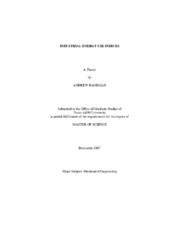| dc.description.abstract | Energy use index (EUI) is an important measure of energy use which normalizes
energy use by dividing by building area. Energy use indices and associated coefficients
of variation are computed for major industry categories for electricity and natural gas use
in small and medium-sized plants in the U.S. The data is very scattered with the
coefficients of variation (CoV) often exceeding the average EUI for an energy type. The
combined CoV from all of the industries considered, which accounts for 8,200 plants
from all areas of the continental U.S., is 290%. This paper discusses EUIs and their
variations based on electricity and natural gas consumption. Data from milder climates
appears more scattered than that from colder climates. For example, the ratio of the
average of coefficient of variations for all industry types in warm versus cold regions of
the U.S. varies from 1.1 to 1.7 depending on the energy sources considered.
The large data scatter indicates that predictions of energy use obtained by
multiplying standard EUI data by plant area may be inaccurate and are less accurate in
warmer than colder climates (warmer and colder are determined by annual average
temperature weather data). Data scatter may have several explanations, including
climate, plant area accounting, the influence of low cost energy and low cost buildings
used in the south of the U.S. This analysis uses electricity and natural gas energy consumption and area data of
manufacturing plants available in the U.S. Department of Energy’s national Industrial
Assessment Center (IAC) database. The data there come from Industrial Assessment
Centers which employ university engineering students, faculty and staff to perform
energy assessments for small to medium-sized manufacturing plants. The nation-wide
IAC program is sponsored by the U.S. Department of Energy.
A collection of six general energy saving recommendations were also written with
Texas manufacturing plants in mind. These are meant to provide an easily accessible
starting point for facilities that wish to reduce costs and energy consumption, and are
based on common recommendations from the Texas A&M University IAC program. | en |


